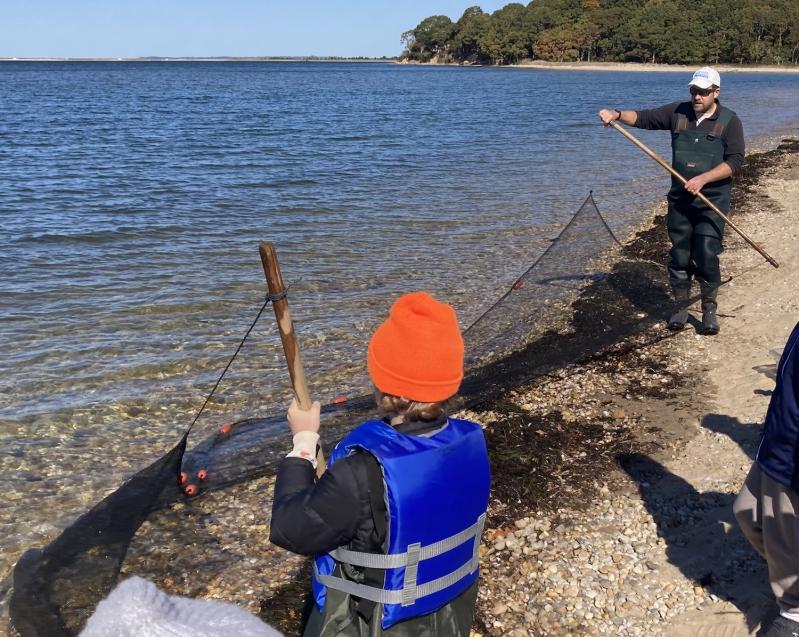Students in schools throughout the East End gathered all around the Peconic Estuary to learn about local river ecosystems and what it means to be a citizen scientist on Friday as part of the Day in the Life environmental program.
Under sunny skies with mild autumn temperatures, Ross School students collected data at Cedar Point while peers from Springs School conducted their experiments at Lazy Point and Louse Point. They each shuffled through three stations, learning about marine life, wind, and the water. As part of these hands-on lessons, students used various scientific tools, such as an anemometer, which measures wind speed and direction.
The students weren’t the only ones learning, however. All the information collected on Friday was sent to Brookhaven National Laboratory for further study.
“The whole goal of all this is to take what we’re doing inside of this classroom and relate it to how it affects the real world,” Sean Knight, who teaches elementary school science at Springs School, said by phone this week. “So, this was probably the greatest trip you can have that goes along with that.”
At the first station for Ross School, Rachel Gruzen, who teaches science to kids in kindergarten through fifth grade, asked the students to use environmental clues to measure the wind. Eventually, going by the nearby leaves and waves, they determined that it was a northeast wind.
John (Barley) Dunne, director of the East Hampton Town shellfish hatchery, taught lessons on acidity and salinity in the water at the second station. He also helped them understand the current by asking a volunteer to toss an orange into the water. With a measuring tape laid out on the beach, the group used a stop-watch to clock how long it took for the orange to drift to the end of the tape measure.
Pete Topping, executive director of Peconic Baykeeper, taught his group at station three about local fish species by catching some specimens with a large net and placing them in water-filled plastic tubs. Then, students counted and identified the fish.
“These bays are like a nursery,” he said to the group. “I think of the ocean as like a college.” When the bay gets cold during the winter months, the fish move out into the ocean.
Nonetheless, Mr. Topping taught that there is more to science than it might first appear: “If you want to study marine science, yes, there’s fun stuff, but you also have to record data and do the not-so-fun stuff,” he said.
Mr. Knight has been taking part in the program since its beginning 13 years ago. With the supermoon having loomed the night before, his students at Lazy Point braved “intense” conditions on Friday.
For the Springs group, Rob Gelling from the South Fork Natural History Museum handled the fish nets, while Mr. Knight took on the shoreline responsibilities.
This year was the first that he took his class to Lazy Point for the program. When Mr. Gelling arrived, he told Mr. Knight that the windy conditions might make data collection tricky. In the past, Mr. Knight and his students accomplished their objectives despite the elements, so he insisted that the group could make it happen.
When the first group went out to gather fish with the net, Mr. Knight said, the tide came up, cutting them off from the rest, so the students had to trudge through marsh-like conditions to get back. The students love to gather and learn about the fish, he added, even though his favorite part is testing the water quality, which the students practiced in science class.
Both Mr. Knight and Ms. Gruzen spoke about “citizen science” — meaning when everyday people observe and report on their environment — which the program seeks to encourage by sending the data to Brookhaven National Laboratory.
“I really wanted to bring this to Ross School,” Ms. Gruzen said toward the end of the morning, adding, “It’s part of teaching kids about the ecosystem, which is in their own backyard.”
“One of the whole goals of this program is citizen science — teaching kids to be responsible for their area,” Mr. Knight said. Later, he added, “I keep telling the kids: ‘Our data is one of the most important. We’re the farthest out east — Amagansett [and] Montauk
aren’t doing this — so we have to keep this thing going.’ ”
The program is organized through a partnership between the New York Department of Environmental Conservation, the Central Pine Barrens Commission, and Brookhaven National Laboratory. Approximately 50 school districts take part across Long Island — though not all on the same day — with most others covering waters much farther west, such as the Carmans River and the Connetquot River.

